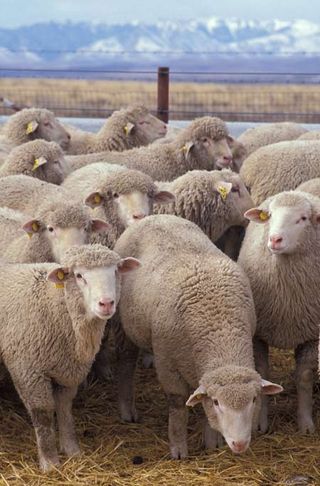Man's Other Best Friend: Shorn, Worn and Eaten for Dinner

Dogs may be the first domesticated animal and man's best friend, but humans owe a lot more to the second domesticated animal — sheep. The domestication of animals occurred at the same time people started to settle down and grow their own food, about 12,000 years ago. Once they planted crops, people rounded up dogs, goats and sheep because those animals were happy to be part of the household. Presumably, dogs were valued for their companionship and goats for their meat and milk, but sheep were the best early livestock because everything about them was, and still is, useful to people. It stared out with sheep as easy human prey. Dr. Warren Gill of the University of Tennessee has written that wild sheep were "undoubtedly nimble and swift," but their flocking instinct made them vulnerable once separated from their kind. All a hunter needed to do was chase one down and smack it with a rock, and he or she gained meat in a small, portable, package, hides for clothing and shelter, and bones that could be carved into tools or ornaments. Dr. Gill also points out that everything about a sheep was good news. For example, the hunter could clean out a sheep's small bladder and fill it with liquid, like an early thermos, something one couldn't do with a mammoth bladder because it would take two or three people to haul that giant bladder around. It wouldn't take long for early humans to see the potential of having these animals much closer to home. Sheep were, in fact, perfect candidates for domestication. There were, and are, docile, quiet, easy to capture and push around. Perhaps that happened over night, when some hunter brought home a few wild lambs that were too cute to eat. Those hand-raised lambs would imprint on whoever fed them, blissfully unaware they were viewed as commodities. Once near at hand, early humans began to selectively breed sheep for certain traits. Take two very meaty sheep and enclose them alone and what you get is an even meatier lamb. Not exactly rocket science, but pretty sophisticated logic for people who had not yet invented introductory biology. Besides breeding sheep and eating sheep, ancient people also understood the value of wool. They'd have noticed the dark brown clumps of fleece left behind by molting wild sheep on bushes on the hillside. Maybe they also noticed the clump of matted wool was really tough, or maybe they simply liked the natural brown color. Whatever the impetus, people probably began to stuff it in their boots and play with it until it felted and became even stronger. And so they started breeding sheep not just for meatiness, but for a thick, soft coat that could be felted or spun into yarn. Of course, humans then had to invent shears to cut off that human-designed coat since selective breeding for meat and wool unexpectedly wiped out the annual molt. Surprisingly, sheep remain important to humans today. And that's because wool is the Swiss Army knife of fabrics, in spite of synthetics. It can be spun, woven, felted, knitted, stretched, shrunk, knotted, twisted, looped and flattened. It absorbs water and remains warm, but dissipates heat in the summer. You can wear it on your head or turn it into a house. And then you can have a leg of lamb for dinner. Not b-a-a-a-h-d. Meredith F. Small is an anthropologist at Cornell University. She is also the author of "Our Babies, Ourselves; How Biology and Culture Shape the Way We Parent" (link) and "The Culture of Our Discontent; Beyond the Medical Model of Mental Illness" (link).
- Top 10 Missing Links
- Amazing Animal Abilities
- 10 Things You Didn't Know About Animals
Sign up for the Live Science daily newsletter now
Get the world’s most fascinating discoveries delivered straight to your inbox.
